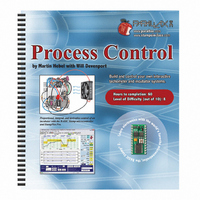122-28176 Parallax Inc, 122-28176 Datasheet - Page 238

122-28176
Manufacturer Part Number
122-28176
Description
GUIDE STUDENT PROCESS CONTROL
Manufacturer
Parallax Inc
Specifications of 122-28176
Accessory Type
Manual
Product
Microcontroller Accessories
Lead Free Status / RoHS Status
Contains lead / RoHS non-compliant
For Use With/related Products
Propeller Education (PE) Kit
Lead Free Status / RoHS Status
Lead free / RoHS Compliant, Contains lead / RoHS non-compliant
- Current page: 238 of 330
- Download datasheet (11Mb)
Page 228 · Process Control
the half-watt resistor also is small. As a result, the overshoot of your system will probably
only be several degrees.
When the temperature does turn around and begins to fall, as it passes the setpoint, the
heater is once again turned on. Undershoot may occur for similar reasons as did the
overshoot. During the time the heater is coming up in temperature, the ambient
temperature has continued downward. Continuous cycling above and below the desired
setpoint is typical of on-off control. The rate of this cycling and the degree of overshoot
depends on the characteristics of the system. On-off control is suitable for processes that
have large capacity, can tolerate sluggish response, and sustain a relatively constant level
of disturbance. If our incubator were large, well insulated, and kept in a constant room
environment, on-off control would be acceptable. After the process has had a chance to
cycle a few times, note the minimum and maximum overshoot values in the minimum
and maximum temperature boxes.
A major problem with on-off control is that the output drive may cycle rapidly as the
measurement hovers about the setpoint. Noise riding on the analog sensor measurement
would be interpreted as rapid fluctuation above and below the setpoint. The timing
diagram in Figure 7-4 represents this problem.
Figure 7-4 Effects of Noise on Signal Causing Heater Cycling
Related parts for 122-28176
Image
Part Number
Description
Manufacturer
Datasheet
Request
R

Part Number:
Description:
MANUAL FOR SUMOBOT
Manufacturer:
Parallax Inc
Datasheet:

Part Number:
Description:
GUIDE STUDENT SMART SENSORS
Manufacturer:
Parallax Inc
Datasheet:

Part Number:
Description:
MANUAL PROPELLER
Manufacturer:
Parallax Inc
Datasheet:

Part Number:
Description:
LEAD WIRES FLYING CABLE III/IV
Manufacturer:
Xilinx Inc
Datasheet:

Part Number:
Description:
BOARD ADAPTER AND FLY LEADS
Manufacturer:
Xilinx Inc
Datasheet:

Part Number:
Description:
PLATFORM CABLE USB II
Manufacturer:
Xilinx Inc
Datasheet:

Part Number:
Description:
KIT STARTER COOLRUNNER-II BUNDLE
Manufacturer:
Xilinx Inc
Datasheet:

Part Number:
Description:
Microcontroller Modules & Accessories DISCONTINUED BY PARALLAX
Manufacturer:
Parallax Inc

Part Number:
Description:
Microcontroller Modules & Accessories DISCONTINUED BY PARALLAX
Manufacturer:
Parallax Inc

Part Number:
Description:
BOOK UNDERSTANDING SIGNALS
Manufacturer:
Parallax Inc
Datasheet:

Part Number:
Description:
BOARD EXPERIMENT+LCD NX-1000
Manufacturer:
Parallax Inc
Datasheet:

Part Number:
Description:
IC MCU 2K FLASH 50MHZ SO-18
Manufacturer:
Parallax Inc
Datasheet:












